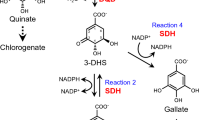Abstract
Main conclusion
Two new peroxygenases for the biosynthesis of epoxy fatty acids in oat were identified and functionally analyzed by heterologous expression along with rationally designed site-directed mutagenesis.
Oat (Avena sativa L.) contains a large family of peroxygenases, a group of heme-containing monooxygenases catalyzing hydroperoxide-dependent epoxidation of unsaturated fatty acids. Here, we report identification and functional analysis of two new peroxygenases AsPXG2 and AsPXG3 from oat. The open reading frame (ORF) of AsPXG2 contains 702 bps encoding a polypeptide of 233 amino acids, while the ORF of AsPXG3 is 627 bps coding for 208 amino acids. Both AsPXG2 and AsPXG3 comprise a single transmembrane domain, conserved histidines for heme binding and a conserved EF-hand motif for calcium binding, but they only share about 50% amino acid sequence identity with each other. When expressed in Escherichia coli and Pichia pastoris, AsPXG3 showed high epoxidation activity, while AsPXG2 exhibited no activity in E. coli and low activity in P. pastoris. AsPXG3 could effectively epoxidize both mono- and polyunsaturated fatty acids with linolenic acid being the most preferred substrate. Site-directed mutagenesis was employed to investigate the structure–function relationship of oat peroxygenase on 12 conserved residues of AsPXG3. Replacement of two conserved histidines, the ligands to the prosthetic heme group of the peroxygenase, by alanine resulted in complete loss of activity. Substitution of three conserved residues surrounding the two histidines resulted in reduction of the enzymatic activity by more than 80%. These results imply that these conserved residues might be located in or near the catalytic pocket, where the two histidine residues coordinate the heme group and the surrounding residues define the shape and size of the pocket for interaction with the heme as well as two substrates.





Similar content being viewed by others
Abbreviations
- PXG:
-
Peroxygenase
References
Blee E, Durst F (1987) Hydroperoxide-dependent sulfoxidation catalyzed by soybean microsomes. Arch Biochem Biophys 254:43–52
Blee E, Wilcox AL, Marnett LJ, Schuber F (1993) Mechanism of reaction of fatty acid hydroperoxides with soybean peroxygenase. J Biol Chem 268:1708–1715
Blee E, Flenet M, Boachon B, Fauconnier ML (2012) A non-canonical caleosin from Arabidopsis efficiently epoxidizes physiological unsaturated fatty acids with complete stereoselectivity. FEBS J 279:3981–3995. doi:10.1111/j.1742-4658.2012.08757.x
Blee E, Boachon B, Burcklen M et al (2014) The reductase activity of the Arabidopsis caleosin RESPONSIVE TO DESSICATION20 mediates gibberellin-dependent flowering time, abscisic acid sensitivity, and tolerance to oxidative stress. Plant Physiol 166:109–124. doi:10.1104/pp.114.245316
Brennan CS, Cleary LJ (2005) The potential use of cereal (1 → 3,1 → 4)-β-d-glucans as functional food ingredients. J Cereal Sci 42:1–13. doi:10.1016/j.jcs.2005.01.002
Delaney B, Nicolosi RJ, Wilson TA et al (2003) Beta-glucan fractions from barley and oats are similarly antiatherogenic in hypercholesterolemic Syrian golden hamsters. J Nutr 133:468–475
Erkkila AT, Herrington DM, Mozaffarian D, Lichtenstein AH (2005) Cereal fiber and whole-grain intake are associated with reduced progression of coronary-artery atherosclerosis in postmenopausal women with coronary artery disease. Am Heart J 150:94–101. doi:10.1016/j.ahj.2004.08.013
Hamberg M, Hamberg G (1996) Peroxygenase-catalyzed fatty acid epoxidation in cereal seeds (sequential oxidation of linoleic acid into 9(S),12(S),13(S)-trihydroxy-10(E)-octadecenoic acid). Plant Physiol 110:807–815
Hanano A, Burcklen M, Flenet M, Ivancich A, Louwagie M, Garin J, Blee E (2006) Plant seed peroxygenase is an original heme-oxygenase with an EF-hand calcium binding motif. J Biol Chem 281:33140–33151. doi:10.1074/jbc.M605395200
Heneen WK, Banas A, Leonova S, Carlsson AS, Marttila S, Debski H, Stymne S (2009) The distribution of oil in the oat grain. Plant Signal Behav 4:55–56
Kapica C (2001) Oats-nature’s functional food. Nutr Today 36:56–60
Leonova S, Shelenga T, Hamberg M, Konarev AV, Loskutov I, Carlsson AS (2008) Analysis of oil composition in cultivars and wild species of oat (Avena sp.). J Agric Food Chem 56:7983–7991. doi:10.1021/jf800761c
Meesapyodsuk D, Qiu X (2011) A peroxygenase pathway involved in the biosynthesis of epoxy fatty acids in oat. Plant Physiol 157:454–463. doi:10.1104/pp.111.178822
Meydani M (2009) Potential health benefits of avenanthramides of oats. Nutr Rev 67:731–735. doi:10.1111/j.1753-4887.2009.00256.x
Murphy DJ (2001) The biogenesis and functions of lipid bodies in animals, plants and microorganisms. Prog Lipid Res 40:325–438
Naested H, Frandsen GI, Jauh G-H et al (2000) Caleosins: Ca2+-binding proteins associated with lipid bodies. Plant Mol Biol 44:463–476
Othman RA, Moghadasian MH, Jones PJ (2011) Cholesterol-lowering effects of oat beta-glucan. Nutr Rev 69:299–309. doi:10.1111/j.1753-4887.2011.00401.x
Paoli M, Marles-Wright J, Smith A (2002) Structure-function relationships in heme-proteins. DNA Cell Biol 21:271–280. doi:10.1089/104454902753759690
Peterson DM, Wood DF (1997) Composition and structure of high-oil oat. J Cereal Sci 26:121–128. doi:10.1006/jcrs.1996.0111
Sadiq Butt M, Tahir-Nadeem M, Khan MK, Shabir R, Butt MS (2008) Oat: unique among the cereals. Eur J Nutr 47:68–79. doi:10.1007/s00394-008-0698-7
Schneider S, Marles-Wright J, Sharp KH, Paoli M (2007) Diversity and conservation of interactions for binding heme in b-type heme proteins. Nat Prod Rep 24:621–630. doi:10.1039/b604186h
Smith LJ, Kahraman A, Thornton JM (2010) Heme proteins—diversity in structural characteristics, function, and folding. Proteins 78:2349–2368. doi:10.1002/prot.22747
Strandberg E, Killian JA (2003) Snorkeling of lysine side chains in transmembrane helices: how easy can it get? FEBS Lett 544:69–73
Acknowledgements
The authors would like to thank Xi Xie for her help in statistical analysis.
Author information
Authors and Affiliations
Corresponding author
Ethics declarations
Conflict of interest
The authors declare that the research was conducted in the absence of any commercial or financial relationships that could be construed as a potential conflict of interest.
Electronic supplementary material
Below is the link to the electronic supplementary material.
Rights and permissions
About this article
Cite this article
Benaragama, I., Meesapyodsuk, D., Beattie, A.D. et al. Identification and functional analysis of new peroxygenases in oat. Planta 246, 711–719 (2017). https://doi.org/10.1007/s00425-017-2729-1
Received:
Accepted:
Published:
Issue Date:
DOI: https://doi.org/10.1007/s00425-017-2729-1




